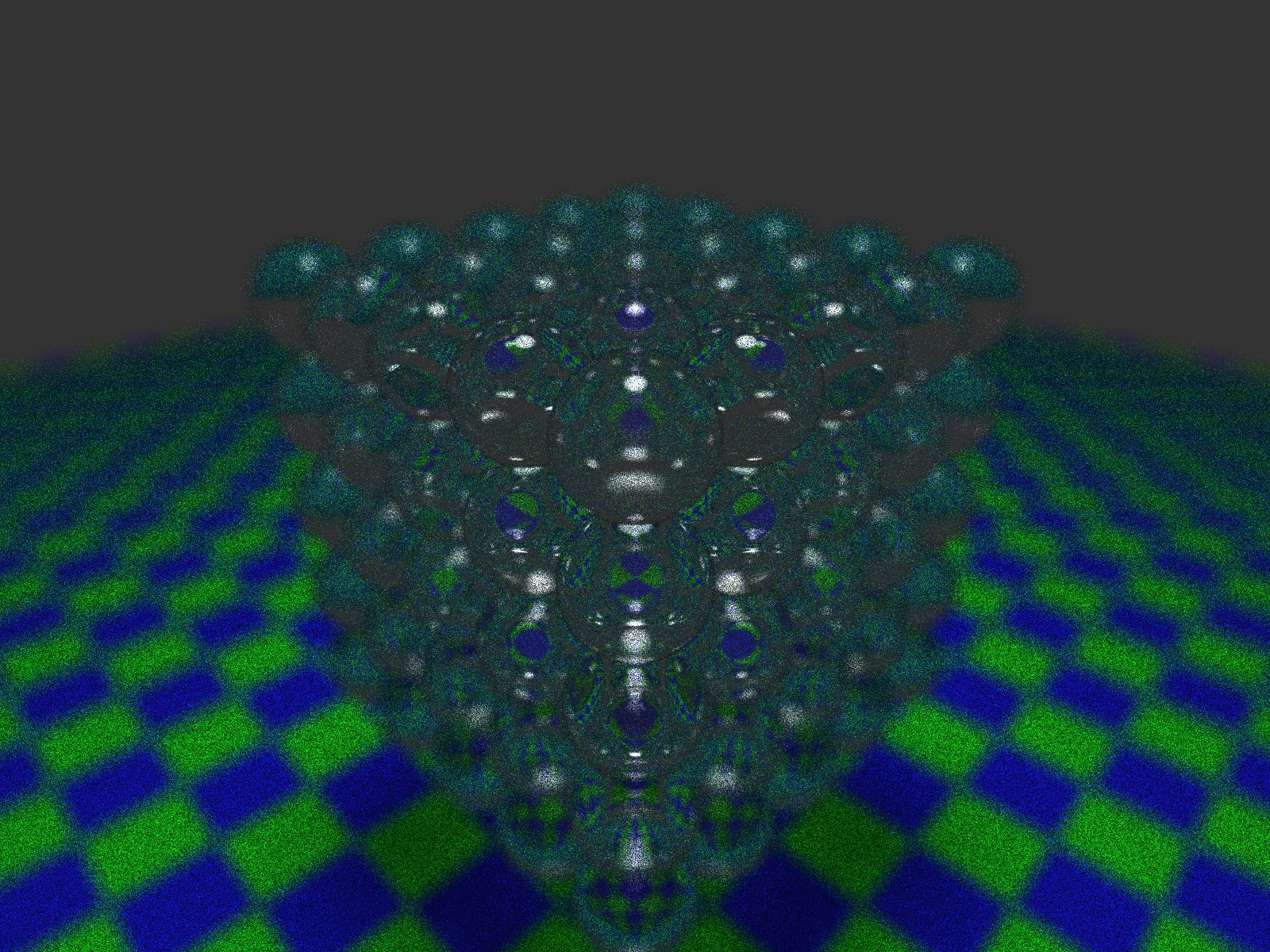Running in the Cloud
With docker we can containarise our software, which helps with deployability of software. Check out docker https://www.docker.com/ and docker-machine https://docs.docker.com/machine/ for background.
With docker you can run and manage containers locally as well as remotely. In the remote case the docker CLI essentailly points to the remote docker-engine. Additionally docker-machine helps provision new instances of machines on cloud services, like DigitalOcean, and AWS and helps maintain some local config (in the environment) to easily switch between different remote connections.
I’m using DigitalOcean for my raytracing cloud runner, since I really like their simple and clean interfaces and APIs. Also the VMs are called Droplets. Now I can render a scene with 32 cores, which is much quicker than running on my laptop locally. Though you have to be carefull of the pricing of the higher end VMs :-)
As a side note: the raytracer is developed using OSX/XCode/Clang and running through docker provides a chance to test compiling and performance and various flavours of Linux as well.
Installing docker-machine
The install on my macbook was straightforward:
- Docker: download docker desktop from https://www.docker.com/products/docker-desktop
- docker-machine: brew install docker-machine, doctl
- create API token: https://cloud.digitalocean.com/account/api/tokens
- login on API:
doctl auth init -t $TOKEN - list droplet sizes:
doctl compute size lsfor example:Slug Memory VCPUs Disk Price Monthly Price Hourly c-4 8192 4 50 80.00 0.119050 c-32 65536 32 400 640.00 0.952380
Using docker-machine
- create VM (ubuntu 18.04 LTS – Digital Ocean):
docker-machine create --driver digitalocean --digitalocean-image ubuntu-18-04-x64 --digitalocean-region sfo3 --digitalocean-size c-32 --digitalocean-access-token=$TOKEN --engine-install-url "https://releases.rancher.com/install-docker/19.03.9.sh" raytracer - activate docker env:
eval $(docker-machine env raytracer) . - deactivate docker env:
eval $(docker-machine env -u) - ssh into remote machine:
docker-machine ssh raytracer - list machines:
docker-machine ls - remove machines:
docker-machine rm raytracer - provision a system: docker-machine (create –> eval … –> docker-compose up)
Cloud Runner
I created a python script to automate the docker-machine calls and I also created a CLI version of the raytracer app. For this cloud runner I also revived an older project of mine https://github.com/aduvenhage/docker-machine-api to automate the docker-machine calls.
Running on Digitial Ocean using all 32 cores:

The script goes through the following steps:
- provision/start VM: docker-machine integrates with the cloud provider API to create the appropriate VM and install docker remotely.
- get machine IP: Get VM IP (not used for anything at the moment).
- get machine environment variables: Get docker-machine env variables required for docker to interact with remote VM. These variables are passed in with each sub-process call so that they apply to the process’s environment, which is required for docker commands to apply remotely.
- get machine status: Check if machine is running or not.
- run services: Do a ‘docker-compose up’ call that runs the raytracer_cli application once.
- secure copy from machine: Copy output image from remote VM back to local host.
- stop machine: Stop remote VM.
- kill machine: Terminate remote VM.
- remove machine: Delete remote VM and cleanup local docker-machine state.
Running in the cloud, you can get much more resources than what is available on a typical laptop, when you need it. The current script creates the VM, runs one frame and then destroys the VM. The overhead of creating and managing the VM is high and the cloud rendering is really only worth-while on frames that take very long to render. Rendering more than one frame at a time is not yet supported.
Some results
For testing I used a scene of stacked glass balls.

I experimented with various droplet types:
- Basic Shared (s): not dedicated, but better hardware than other types
- CPU-Optimized (c): dedicated, but older generation hardware
- General Purpose (g): general purpose (somewhere in the middle) droplets
- General Purpose Dedicated (gd): general purpose droplets
The raytracing tests use very little memory and disk with mostly short periods of high CPU utilisation. The following table shows rendering results on my Macbook and on different DigitalOcean droplets:
| VM Type | Timing (s) |
|---|---|
| DO c-2 | 420 |
| DO c-4 | 223 |
| macbook pro 2017 (8 cores) | 115 |
| DO c-8 | 110 |
| DO s-8vcpu-16gb-intel | 94 |
| DO s-8vcpu-16gb-amd | 87 |
| DO c-16 | 59 |
| DO c-32 | 32 |
| DO gd-40vcpu-160gb | 32 |
| DO g-32vcpu-128gb | 30 |
It clearly shows how well raytracing can scale with more cores and the results on DigitalOcean match quite well with the results on my macbook.
These results exclude the overhead of provisioning, compiling and deleting the remote VMs, which adds around 3 minutes to the total run time. This is a fairly large overhead and probably makes running in the cloud worthwile only if the scene rendering time would have been an order of magnitude larger than this. Some work has been done to make the docker image build faster (using a base image, etc.) but the VM provisioning just takes time.
Final Thoughts
I could get the cloud runner to work on AWS as well, and AWS has some very capable VM options. Unfortunately I found working with AWS web interface extremely painful. On top of that, the fact that you can get locked out of an old account (and never be able to re-use that email address again for an AWS account) is just, well, horrible.